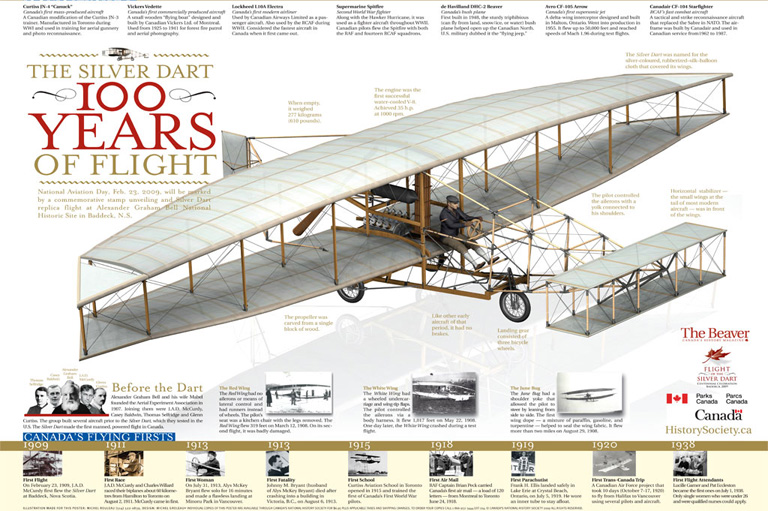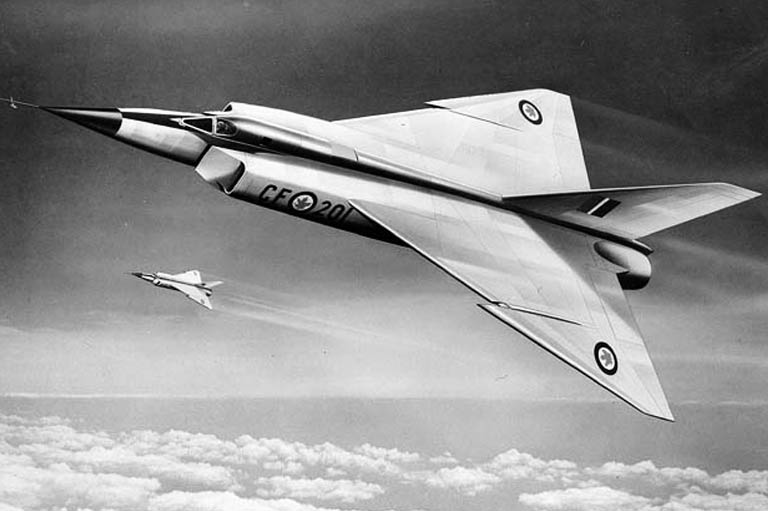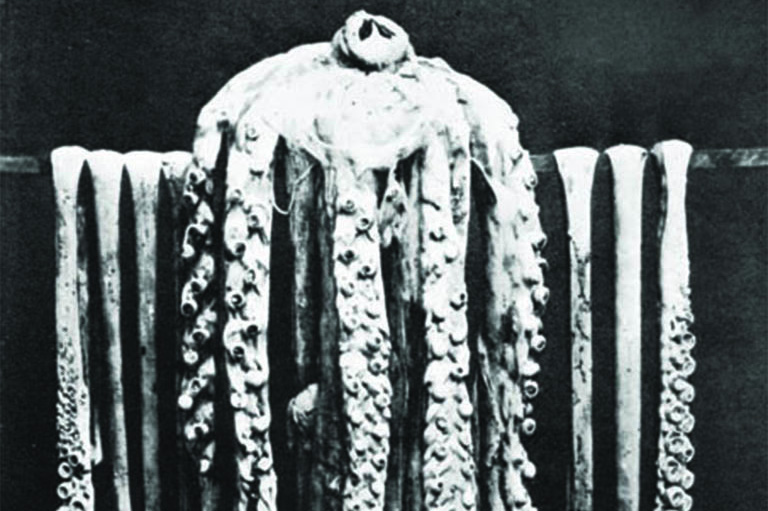Early Northern Air Mail
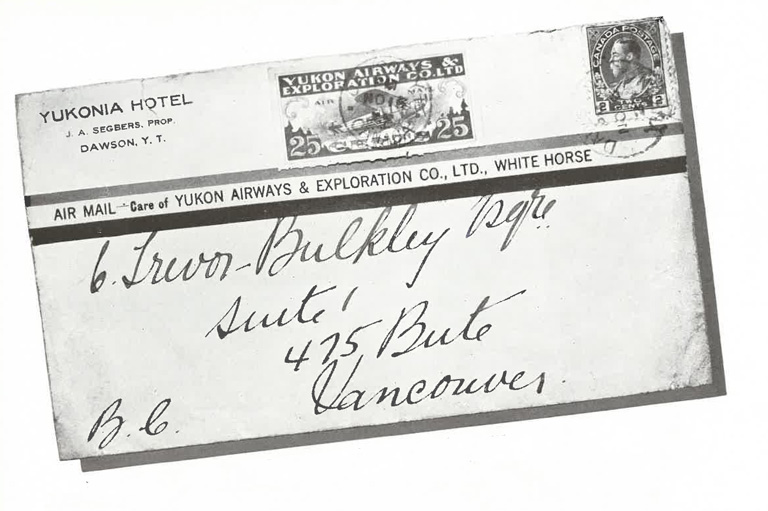
The carriage of mail by air to and from most of the settled areas in northern Canada has become such a reliable and frequent part of our country’s way of life, that it is now taken for granted. All first class mail in Canada today, which weighs under eight ounces, is carried by air, wherever scheduled air lines operate.
Back in the early thirties, however, the pioneer flying companies didn’t have too happy a time flying mail into the areas they served. Most of them originally took on the job of their own free will, because it meant some added revenue; and in those lean days, when every cent counted, the additional money earned often meant getting out of the red side of the ledger.
Over all of the pioneer routes, flying companies were obliged to issue their own stamp-like stickers, which were sold and placed on the back of all covers. The cost varied according to the letter or parcel weight, and the distances flown. Permission to make use of such stickers, and to carry the mail by air, had first to be obtained from the postal authorities at Ottawa. Perhaps they added their good wishes too, but if so, that was all the aid they gave in the early days. Throughout almost all of the twenties, they awarded no contracts, nor gave financial aid, probably waiting to learn whether it was to become a worthwhile project or not before going further into the matter.
A large number of the very earliest air mail flights were just a single trip or two between two points, made by pilots of fling firms who wished to create a bit of publicity or establish a precedent. There were many such ventures throughout Canada and Newfoundland from 1918 to 1930. The make a lengthy and interesting story. Here however I am dealing strictly with air mail progress in the North country, so many of the early flights in the south must be omitted.
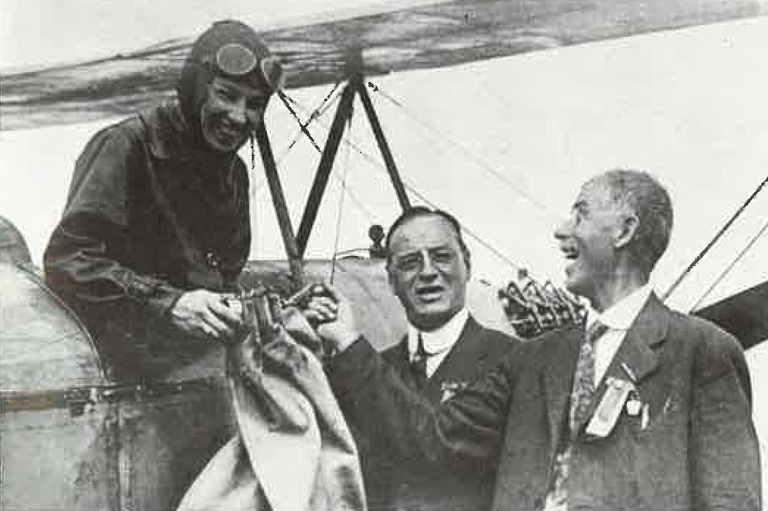
Today, the city of Edmonton is rarely defined as being in the north because the expansion and growth of industry has robbed it of that distinction. But back in 1918 it was different, and it seems only right that the flight of a daring young American airwoman from Calgary to Edmonton in 1918 should be classed as the first air mail flight north. The pilot was Katherine Stinson, who thrilled the people of Canada’s three prairie provinces at many points during flying exhibitions given in 1916 and again in 1918.
After flying at Calgary in her single-seater Curtiss biplane in July. 1918, she announced that she intended to fly to Edmonton, where her next contract was to be filled. Plans were at once made for her to carry letters on the flight, an officially sanctioned cachet was hastily made, and imprinted on the 380 envelopes which were in the mail bag when she flew them north.
The flight took place on July 9th, commencing from Calgary's exhibition and concluding at the Edmonton exhibition grounds. The young pilot left Calgary at 1:03 p.m., intending to fly non-stop, but engine trouble forced a landing at the small town of Baddington, and she did not reach Edmonton until 8:00 p.m. A large crowd on hand gave her a tumultuous welcome. Few of the letters flown have survived today, but those which have are valued at $200.00 each.
As the first official air mail in Canada had been carried only fifteen days before, when Captain Brian A. Peck of the Royal Air Force had flown a mail bag containing 120 letters from Montreal to Toronto, it turned out that only by chance was the first air mail flown in Canada by a Canadian pilot.
Following Miss Stinson’s flight, the next of importance to take place into the north was made by a Major F. S. Cotton of St. John's. Newfoundland. Shortly after World War I, he and a Captain Bennett organized the Aerial Survey Company, with two aircraft purchased from England, a Martynside and a Westland. Fitted with skis, they were the first airplanes to take to the air in Newfoundland, and many passenger and air mail flights resulted. The chief one of interest here is the flight made by Cotton in the Martynside as an air mail venture from St. John’s to Cartwright, Labrador. His was the first airplane ever to touch down in that northern area.
Cotton took off with the mail from St. John’s on February 8, 1923, but an accident to the landing gear on arrival at Botwood delayed the flight until May 16, when it was completed to Cartwright. To make up for the bad showing, the airman left the Labrador settlement on the 17th and landed at St. John’s the same day. Very few of the letters and envelopes have survived the years.
Up to this time there had been no regular air mail service put into operation by a Canadian company. The first was organized by the Laurentide Air Services Limited. As a separate company from the parent concern, the Laurentide Pulp and Paper Company, the service was inaugurated in 1922. Their main bases were established at Haileybury and Larder Lake. Ontario, with smaller ones at Three Rivers. Angliers and Rouyn. P.Q. Their first flight carrying mail to which their air mail stickers were attached was on September II. 1924. The company ceased operations in 1926.
The operations of the Jack V. Elliot Air Service were chiefly confined to the newly discovered Red Lake goldfield area in northern Ontario. Pilot Jack Elliot, owner-manager, flew the first air mail himself, going in from Rolling Portage to Red Lake on March 6, 1926. Fairchild Air Transport also began operations in the same areas in 1926, and their first air mail flight, made from Rouyn to Haileybury by Glyn R. Burge, was on October 20, 1926.

In the same year, Patricia Airways & Exploration Company Limited came into the picture, under the guidance of pilot-manager H. A. “Doc” Oaks, who did a lot of flying for the company as well as running things in the office, and who later organized Western Canada Airways. Pilot Roy Maxwell took delivery of their first machine from the dealer in New York, flying the craft to Red Lake, via Toronto-Sudbury-Pogamasing and Sioux Lookout.
Between New York and Red Lake the letters flown totaled less than one hundred. The flight took place beginning March 27 and ending April 12, 1926. In spite of the small number of letters carried, the value today of the ones which reached Red Lake are rated in stamp catalogues as being worth only $18 each.
Varied types and makes of aircraft were used by all these pioneer companies, but all of the machines were either flying boats or seaplanes for use during the open water seasons, and ski equipped airplanes during the winter months.
In November 1927, the first air mail to be flown in Yukon Territory went out of Whitehorse in a machine owned by the Yukon Airways & Exploration Company Limited, piloted by Andy Cruickshank. A Ryan monoplane, named Queen of the Yukon, the craft took off on the 11th with a load of mail for Dawson and Mayo. Aboard was the pilot’s wife, as helper. As they winged over Dawson, Mrs. Cruickshank thrust a mail bag out of the cabin window, and the machine flew on non-stop to Mayo to finish the day’s work. It was forty below at the time.
The return flight left Mayo on the 16th. with a one day stop at Dawson on the way before setting off again for Whitehorse. At the period when all of these early air mail flights were taking place, the north shore hamlets along the Gulf of St. Lawrence were quite often isolated during the severe storms of the winter months. Until 1927, no air mail of any description had been flown either in Canada or in Newfoundland directly under government contract. Therefore that year marked a decidedly progressive step forward in our flying history, because the Dominion government finally became aware of the fact that air mail was becoming a popular and a paying proposition.
Government sponsored flights to and from Rimouski in connection with incoming and outgoing liners began in 1927, but what was better from the commercial flying companies’ point of view, five government contracts were awarded for the flying of scheduled mail. In the post office estimates for 1927, $75,000 was set aside for air mail development.
One of the contracts went to the Quebec firm of Canadian Transcontinental Airways. The Post Office department required the delivery of winter mail between Murray Bay and Seven Islands, along the north shore of the St. Lawrence. A weekly return flight to the island of Anticosti, 45 miles out in the gulf, was also included in the contract. It called for the carriage of 1500 lbs. or less weekly between the various points along the coast.
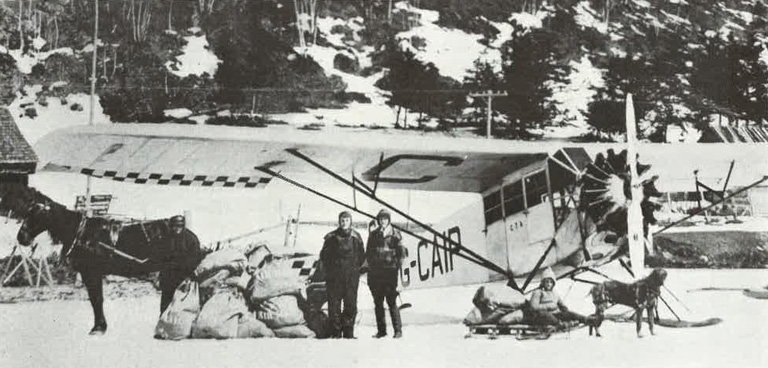
One of the C.T.A. pilots, Romeo Vachon, was despatched by train to New York to take delivery of a new Fairchild monoplane, with orders to fly it back to La Malbaie, the company base at Murray Bay. He arrived there on December 21, having flown non-stop from New York. When flying over Quebec City he had circled the airport there, and dropped a bag of mail by parachute, the first time in Canada’s history that such a method of delivering mail had been put into use. The mail bore no stamps, but it was later officially cancelled by the Quebec post office and delivered to its various addresses. A single cover today is worth $25.
The one and only delivery of air mail along the St. Lawrence north shore in 1927 took place on December 25. Pilot Vachon made the run from La Malbaie to Seven Islands, with a total load to start of 753 lbs. of Christmas mail. Deliveries at most of the points on the way were made by parachute drop, and there were many happy people along that isolated shoreline when the flying postman came winging out of the east just at the psychological time.
By 1929, flying was getting well under way in the North, and pilot “Punch” Dickins, of Commercial Airways, happened to be at Fort McMurray on January 23, 1929, in readiness to take off on company business for Fort Simpson. Due to various causes, chiefly bad weather, mail deliveries for the north had piled up at Fort McMurray awaiting ground transport. When it was suggested that Dickins could deliver the mail bags at the various points between McMurray and Fort Simpson, the company jumped at the opportunity of making some extra money. Thus the first mail went north by air, almost at a minute’s notice, and without previous planning. On his return from Simpson, Dickins flew out a valuable cargo of baled furs, the first time in western Canada’s history that these products of the north had come out by air.
The same year two privately chartered aircraft had set off on a lengthy flying tour into eastern arctic areas, financed by mining interests, and under the leadership of Colonel C. D. H. MacAlpine. One of the aircraft, flown by pilot Stan R. McMillan, achieved a bit of northern fame by dropping the first mail ever to be delivered in the eastern Arctic.
As the airman and his two passengers winged north along the eastern shoreline of Hudson Bay, en route from Chesterfield to Tavane and Baker Lake, they circled the Hudson’s Bay post at Eskimo Point on April 2, to throw out a single letter addressed to the padre there. It was attached to the leg torn from an old pair of pants, which acted as a streamer to attract attention, and make it easier to locate on the snow. The aim was good however, and it landed almost at the feet of the minister as he stood waving at the door of one of the buildings.
At long last came the day when the first official air mail under full contract was to reach Arctic shores. The event was widely publicized and the result was staggering.

Commercial Airways Limited of Edmonton received the contract, and on December 30, 1929, the first official air mail reached Aklavik. Three aircraft were used in the project between Edmonton and Fort McMurray, and two, flown by W. R. “Wop” May and Glyn Roberts, completed the haul from McMurray to the various stop-over points between McMurray and Aklavik, which consisted of thirteen altogether.
As this was a government-sponsored first flight, 26 distinctive cachet designs were used on the various envelopes addressed to the various points enroute and return. Being so well advertised ahead of time, the amount of mail which arrived was tremendous. “First flight” fans and collectors sent mail in from all over the world, and by the time the flight got underway, 120,000 letters had been received by the Edmonton post office, weighing four tons.
Three new Bellanca cabin-type monoplanes were purchased by Commercial Airways to inaugurate the run, together with a new Lockheed “Vega” monoplane, all four being ski-equipped. The latter was used only as far north as Fort Simpson, the Bellancas doing the job between that point and Aklavik.
The huge bulk of mail made it necessary to fly the bags in and out in relays, to and from their various destinations. The start from McMurray over the 1600-mile route began on December 10, 1929, seventeen days being required to fly it all in. At Fort Simpson, where the airmen spent Christmas Day, the mercury dropped to sixty below, and on Boxing Day, when they continued north, it stood at forty-four below. The two engineers who serviced the planes, Sims and Vanderlinden, did yeoman work keeping the engines in running condition throughout the night. The planes stood right out in the open in the sub-zero temperatures. All they had for warming-up jobs were ordinary blow torches and plumbers’ fire pots, and simple flashlights were their only means of illumination.
By the time the two airmen had delivered the last bag to Aklavik, a total of 6000 miles had been flown by the four aircraft, and most of the four tons still had to be flown out to the philatelists who had written the letters to themselves. In spite of the risk, work and expense involved in flying the two-way letters in and out. there was so much of it. a single specimen is valued at only fifty cents today. If signed by the pilots, it is worth $5.00.
How air mail began in the Yukon has already been recounted. The final link by air between that territory and the outside world was forged by United Air Transport, Ltd., who had established a chartered air service between Edmonton and Whitehorse in 1934. Carrying air mail in an unofficial capacity began on July 7, 1937.
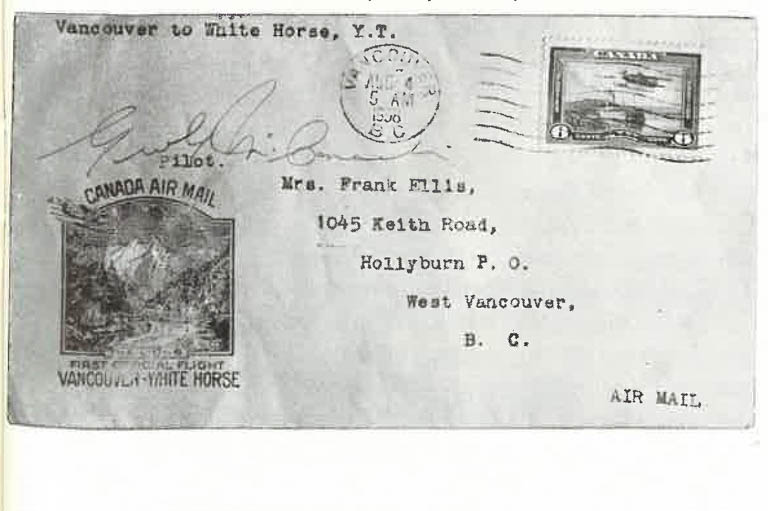
The first direct connection from Vancouver to Whitehorse began on August 4, 1938, when two aircraft of the company left the Vancouver Sea Island airport for the northern points. One was a twin-engined Fleet seaplane, piloted by Grant McConachie, with Ginger Coote as copilot, the other, flown by pilot Sheldon Luck, was a single engined Norseman seaplane. 20,000 air mail letters which the post office department received to be cacheted and flown as first flight mail, went north aboard the two machines.
While all this northern air mail progress was underway in Canada, similar routes were fast being established in many other parts of the country from coast to coast, and to various other northern areas which space does not permit mentioning here.
Since the flights by Captain Peck and Miss Stinson, which totalled 500 letters between them, the business of flying the mail in Canada has grown to millions of pieces a year, a development which was undreamed of in 1918 when the first air mail flights were made.
Themes associated with this article
Advertisement
You might also like...

Canada’s History Archive, featuring The Beaver, is now available for your browsing and searching pleasure!

